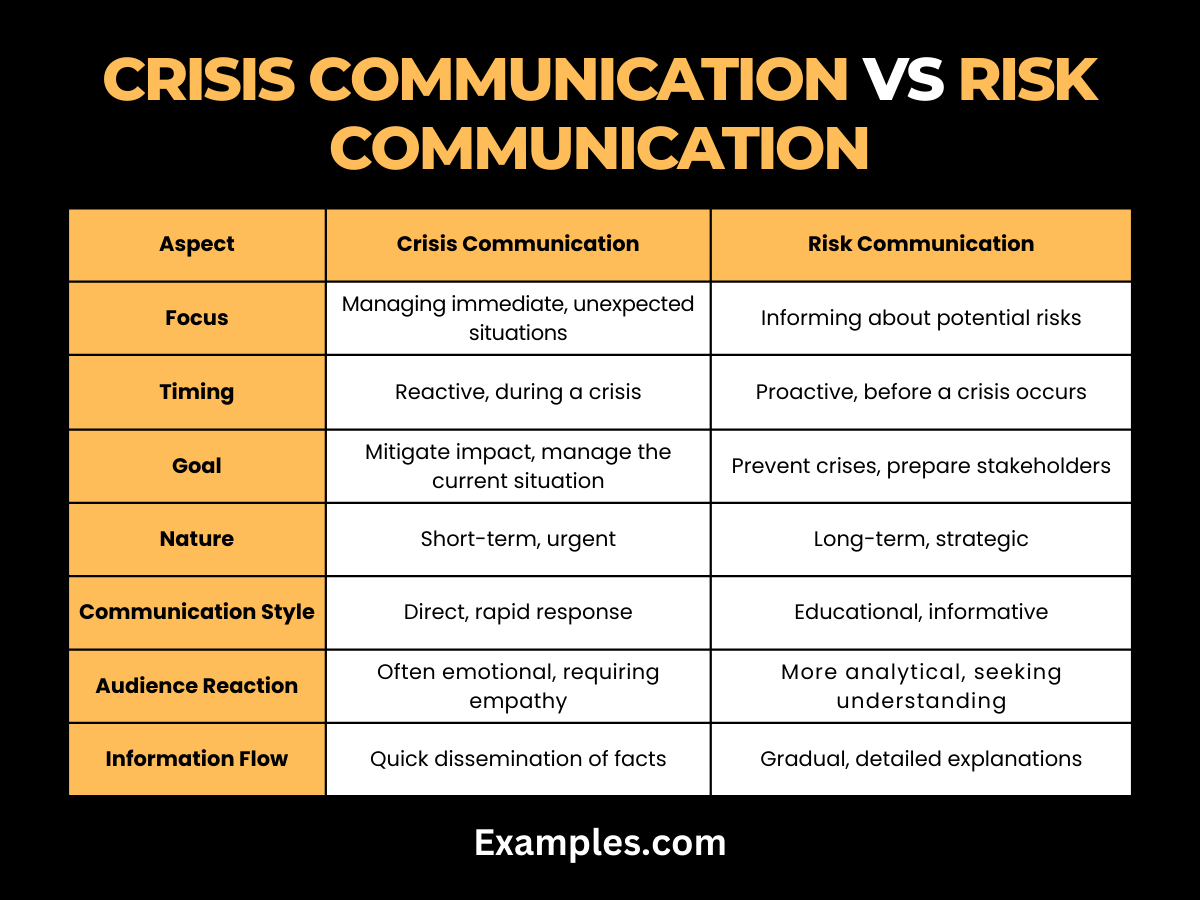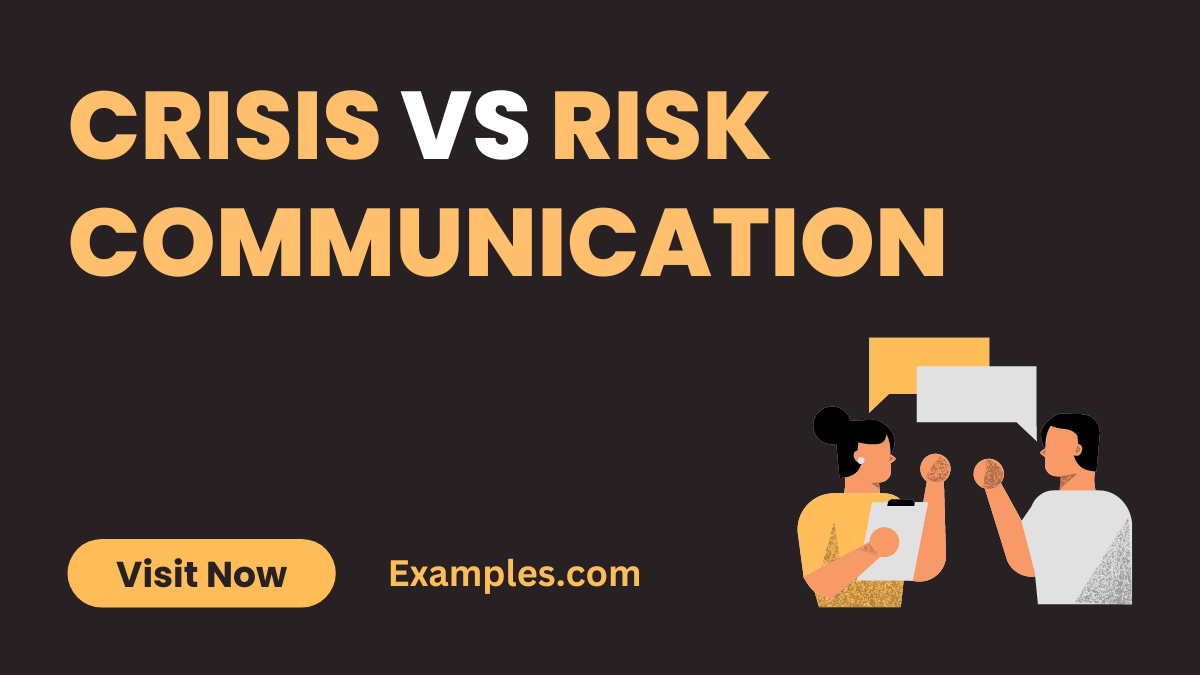Crisis vs Risk Communication – 9+ Examples
Navigating the nuances between Crisis Communication and risk communication is essential for effective management in challenging situations. This section explores the distinctive features of each, underscoring their importance in organizational strategy. While crisis communication deals with immediate response and management of unforeseen events, risk communication focuses on preemptive measures and informing stakeholders about potential risks. Understanding these key differences is crucial for implementing the right communication strategy at the right time.
What is Crisis vs Risk Communication?

Crisis communication and risk communication are two distinct but interconnected facets of organizational communication. Crisis Communication involves managing and disseminating information during an unexpected, often urgent situation. It’s about immediate response, mitigation, and maintaining trust in real-time. Conversely, risk communication is the process of informing and educating stakeholders about potential risks before they become crises. It’s proactive, focusing on prevention and preparedness, aiming to reduce uncertainties and build resilience.
What is the Best Example of Crisis vs Risk Communication?

A clear example of the distinction between Crisis Communication and risk communication can be seen in natural disaster management. Risk communication occurs when meteorologists inform the public about a potential hurricane days or weeks in advance, focusing on preparedness and preventive measures. In contrast, Crisis Communication happens when emergency services communicate during the hurricane, providing real-time updates, instructions, and support to those affected, addressing the immediate crisis at hand.
Difference Between Crisis and Risk Communication

Understanding the difference between Crisis Communication and risk communication is key to managing organizational challenges effectively. Here’s a table highlighting the main differences:
| Aspect | Crisis Communication | Risk Communication |
|---|---|---|
| Focus | Managing immediate, unexpected situations | Informing about potential risks |
| Timing | Reactive, during a crisis | Proactive, before a crisis occurs |
| Goal | Mitigate impact, manage the current situation | Prevent crises, prepare stakeholders |
| Nature | Short-term, urgent | Long-term, strategic |
| Communication Style | Direct, rapid response | Educational, informative |
| Audience Reaction | Often emotional, requiring empathy | More analytical, seeking understanding |
| Information Flow | Quick dissemination of facts | Gradual, detailed explanations |
| Frequency | Intense during the crisis | Consistent over time |
| Stakeholder Engagement | High during crisis | Steady, building awareness |
| Outcome | Resolution of the immediate crisis | Enhanced preparedness and prevention |
10 Examples of Crisis Communication
Crisis Communication plays a crucial role in managing immediate, high-stress situations effectively. It involves clear, concise, and empathetic messaging to inform and reassure stakeholders during an unexpected event. Here are ten examples showcasing how Crisis Communication should be executed, each demonstrating the importance of timely response, factual accuracy, and maintaining public trust.
- Natural Disaster Response:
Example: “We are closely monitoring the hurricane and have evacuation plans ready. Your safety is our top priority.
“Rapid updates and safety instructions during natural disasters. - Product Recall Announcement:
Example: “Due to potential safety risks, we are recalling Product X. Here’s how you can return it and get a refund.
“Transparency and instructions in a product safetyissue. - Data Breach Notification:
Example: “We’ve experienced a data breach. We are working tirelessly to secure your information and prevent future incidents.
“Immediate acknowledgement of the issue and reassurance of corrective measures. - Public Relations Crisis:
Example: “We apologize for the recent advertisement. It was insensitive and we are reviewing our content approval process.
“Apology and commitment to change in response to public backlash. - Financial Instability Announcement:
Example: “Despite financial challenges, we are exploring all options to stabilize our company and protect our employees.
“Honest communication about financial issues and steps being taken. - Leadership Scandal:
Example: “We are aware of the allegations against our CEO. An independent investigation is underway.
“Neutral and factual response to allegations involving leadership. - Service Outage Update:
Example: “Our service is currently down due to technical issues. We are working to restore it as quickly as possible.
“Prompt update and reassurance during service disruptions. - Environmental Crisis Response:
Example: “In response to the oil spill, we are coordinating with authorities and environmental experts to mitigate the impact.
“Proactive and responsible communication in an environmental emergency. - Health Crisis Update:
Example: “In light of the health crisis, we are implementing safety measures and following government guidelines.
“Information on safety protocols during a health emergency. - Legal Issue Transparency:
Example: “We are currently facing legal challenges, but remain committed to operating with integrity and transparency.
“Communicating legal issues while reassuring commitment to ethical practices.
10 Examples of Risk Communication
Effective Risk Communication is about proactively identifying and discussing potential risks with stakeholders. It involves educating and preparing them for possible future scenarios. These examples highlight how to communicate potential risks clearly and effectively, focusing on preparedness, prevention, and building trust.
- Health Risk Advisory:
Example: “To reduce health risks, we recommend vaccination and regular health check-ups.
“Advising on health precautions to prevent diseases. - Financial Risk Disclosure:
Example: “Investing in this venture carries financial risks due to market volatility. Please consider carefully.
“Transparency about potential financial losses in investments. - Weather-Related Risk Warning:
Example: “Severe weather expected this weekend. Secure your property and stay informed.
“Preemptive advice for potential natural weather hazards. - Cybersecurity Alert:
Example: “Be aware of increased phishing attempts. Do not share personal information online without verification.
“Educating about online security threats and preventative measures. - Environmental Risk Information:
Example: “Chemical X has potential environmental risks. Handle with care and follow disposal guidelines.
“Informing about environmental hazards associated with chemicals. - Travel Risk Guidance:
Example: “Traveling to Region Y carries risks due to political instability. Keep updated on the latest travel advisories.
“Pre-travel advice considering the geopolitical climate. - Product Usage Caution:
Example: “When using Product Z, follow safety instructions to avoid potential hazards.
“Instructions to mitigate risks associated with product use. - Construction Safety Notice:
Example: “Construction area ahead. Wear protective gear and adhere to safety protocols.
“Warning about potential dangers in construction zones. - Disease Outbreak Preparedness:
Example: “In case of an outbreak, maintain hygiene practices and avoid crowded places.
“Preparing the public for potential health crises. - Emergency Procedures Education:
Example: “Familiarize yourself with emergency exits and procedures in case of an evacuation.
“Educating about actions to take during emergencies.
Comparisons Between Crisis and Risk Communication
In comparing Crisis Communication with risk communication, several key points emerge:
- Urgency: Crisis communication is often marked by a high level of urgency, while risk communication is generally more measured and ongoing.
- Focus: Crisis communication focuses on managing and resolving a current crisis, whereas risk communication aims to prevent and prepare for potential risks.
- Audience Reaction: In crisis communication, audiences often react emotionally and seek immediate information, while in risk communication, the audience is more likely to seek understanding and engage in dialogue.
- Nature of Communication: Crisis communication typically involves direct and rapid responses, while risk communication involves more educational and informative content.
- Timing: Crisis communication is reactive, occurring during or immediately after a crisis, while risk communication is proactive, occurring before a crisis.
- Information Flow: The flow of information in crisis communication is quick and aimed at disseminating facts, whereas in risk communication, it involves gradual and detailed explanations.
- Frequency: During a crisis, communication is intense and frequent, while risk communication is more consistent over time.
- Stakeholder Engagement: Engagement is high and immediate during crisis communication, while it is steady and focused on building awareness in risk communication.
- Outcomes: The immediate goal of crisis communication is to resolve the current crisis, while risk communication focuses on long-term preparedness and prevention.
- Communication Style: Crisis communication often requires a more commanding and assertive style, whereas risk communication is more consultative and advisory.
Relationship Between Crisis and Risk Communication
The relationship between Crisis Communication and risk communication is intricate and interdependent:
- Foundational Basis: Risk communication serves as a foundational basis for effective crisis communication.
- Preventative Role: Effective risk communication can prevent certain crises from occurring.
- Strategic Planning: Both are integral parts of strategic planning in organizations.
- Stakeholder Trust: Success in both areas builds and maintains stakeholder trust.
- Information Sharing: Information shared during risk communication can be crucial during a crisis.
- Feedback Loop: Feedback from crisis communication can inform risk communication strategies.
- Resource Allocation: Both require adequate resources for effective implementation.
- Training and Preparedness: Training for crisis communication often includes elements of risk communication.
- Policy Development: Organizational policies should encompass both crisis and risk communication.
- Continuous Improvement: Learnings from each can be used to improve the other.
Understanding the nuances between Crisis Communication and risk communication is key to effective organizational management. This guide has equipped you with strategies and tips for both, emphasizing proactive risk management and efficient crisis response. By mastering these communication forms, organizations can better prepare for potential challenges and manage crises with confidence, ensuring resilience and trustworthiness in any situation.



